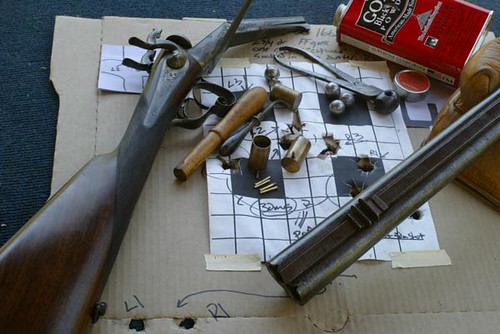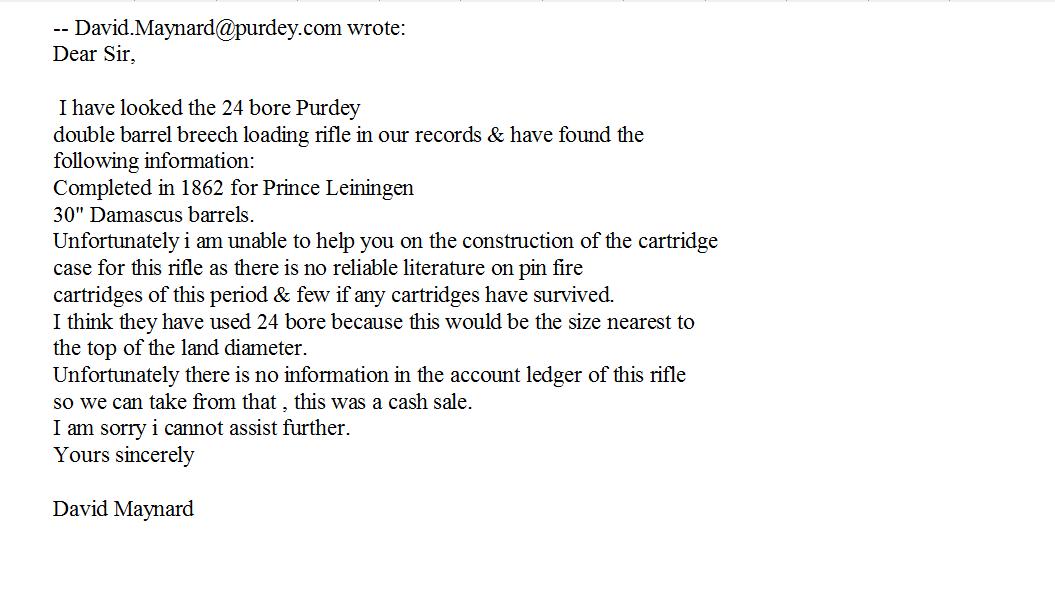| tinker |
| (.416 member) |
| 29/08/08 04:19 PM |

|
|
|
Mehul, Curl-
Yes, there is some very interesting provenance on this rifle.
To start, I should note that I've never before felt that I 'needed a Purdey'
I'd heard of the seductive handling and finish and accuracy and magic of the London Best,
but the aura just hadn't ever drawn me to pursue ownership of anything with the name.
For one thing, I've been perfectly happy with the high quality European arms I've found,
and for another, I've always realized that much of the innovation and development started
over on the Continent, and was brought over to England during the Golden Age and refined,
patented, and hearlded around the British Empire.
I'd have been fine to not have ever parked a Purdey in my vault.
With more time on my hands than I'd like during the recovery from knee surgery, I caught the
listing of this rifle, Purdey #6275, at the moment it hit the World Wide Web.
As you've come to notice, I tend to get excited about light sporting double rifles with damascus
barrels built around the pinfire system.
That's the kind of thing that gets a double take from me, note that I have a couple of sixteen
bore rifles of similar configuration.
There were some things about this one that really put the hook in me, one being that it was
a light twenty bore, another being that it had been built with set triggers for both barrels.
The latter feature was very unusual for a Purdey, Unsworth notes that a Purdey double rifle
from the period with any set trigger, let alone two of them, was all but unheard of.
The only exception he notes is a SxS muzzle loading rifle made the year before for "highly
experienced big game hunter, Sir Fancis Sykes".
I bit the hook.
Before the end of the night I'd composed and sent a piece of mail to the dealer.
Recanting some previous discussions we'd had in the past few years, I noted that I have
particular interest in the pinfire system and the sporting arms of the transitional period.
I briefly detailed a couple of other rifles of similar configuration that I'd brought out of
their hundred-plus year sleep, developing components, tools, and loads for and taking them
to the field.
I asked him to consider me a qualified buyer for the rifle and engaged in working a deal
with him on the neat little Purdey.
Within three or so weeks I had the rifle here in my hands, doing what I could to keep myself
from getting attatched to it. I'd asked for an extended evaluation period and was granted
some very reasonable terms. There would be a lot of work to do before I could fire it, and
I wanted to hear it bark before I called it mine.
As is noted above, I ended up finding the need to start from the ground up with this one.
One of the first things I did when I pulled the rifle from the case was attempt to stuff a
period 20b Pinfire case into the chambers.
No dice. The hull wouldn't fit. I also had a 24b new old stock case on hand and tried it too.
Again, no dice -- this time the case was too small for the chambers.
Hmmm...
I grabbed the caliper and did a quick check of the groove diameter at the muzzles, and found
relatively standard 20b grooves measuring ~.620"
The grooves were wide and shallow, taking a turn in about sixty inches.
I really expected one of my paper cases from the 1860's to chamber, but it wasn't happening.
I then took a telescoping gage and snapped it into the throats of the chambers. Then I did
the same thing to the leade end of the bores. What I found just didn't seem right. There
wasn't enough step to allow a groove sized bullet to fit into the mouth of a paper case.
From there I set up and slugged the bores and the throats, then cast the chambers.
What I got was clearly a space asking for thin case walls - just about .015" at the necks,
way too thin for a paper case and just about perfect for thin brass.
I went directly to Unsworth's Early Purdeys, straight back to the appendix specific to rifles.
I picked through every listed cartridge rifle in the list. The only mention to cartridge
type was of paper cases, nothing noting metallic cartridge construction.
It was then that I realized that this rifle was the 37th cartridge rifle that Purdey made.
This is one of very few to have been made with the Jones type double bite underlever system.
Purdey introduced their patent double bite (push forward snap action) the next year.
I spent the next few days rummaging through my old texts and what saved files I have from old
catalogs. I searched the web looking for dated evidence of thin metallic cases from as early
a date as the completion date of this rifle. I called around and spoke with a the usual suspects
one would think to call on this kind of topic. The resounding opinion was that in 1862 there
was no such thing as a thin walled metallic 20b pinfire cartridge case.
This rifle said otherwise.
I got in touch with David Maynard of Purdey's asking him to detail the process by which I
needed to follow in order to get a peek into what records there might be.
I noted the configuration of the rifle, with emphasis on the chambers, asking for whatever he
could find on the cartridge type specified on the leger.
What I got back from him didn't give me much on the chambers, but it did spark curiosities in
another area.
Here's a copy of Mr Maynard's comments.

Prince Who?
That piece of mail sent me into a three or four night tryst with google.
I was very surprised to find what I did...
--Tinker